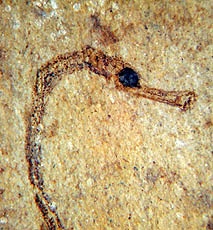In the Middle Miocene about 11 million years ago or, to be more precise, in the period called the Sarmatian, an interesting succession of fine-grained sediments was deposited in the hills of modern-day Tunjiško gričevje (now layers of grey siltstone and marl), in which, in addition to numerous snails and shells, an unusual and wonderful assemblage of fossils has survived that cannot be found anywhere else in the world. The characteristic fossils of these layers are excrements (coprolites), after which these layers acquired the name “coprolite horizon”. These layers are remarkable mainly owing to the numerous insects, plant remains of marine and land plants, with many up to tens of centimetres long fishes also found there. The most imposing are the remains of seahorses, which as the oldest fossils of this group of fish on Earth belong not only to our national but also to the world’s natural heritage. At the age of 11 million years, the seahorses from the coprolite horizon are by about 6 million years older than the oldest documented fossil seahorses discovered in Italy. Although most of the fossils from the coprolite horizon layers are small and hardly visible to the naked eye, some of these finds are truly wonderful. Even the smallest details have survived, such as eyes, different types of hairs, spikes, stings and ovipositors in insects, and skin colour in fishes. Even soft-bodied organisms, such as jellyfish, have survived in these layers.


